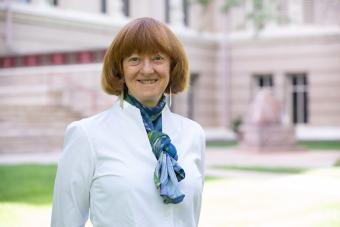Wendy Bohrson joins Mines as Geology Department head

Wendy Bohrson has been named the head of the Geology and Geological Engineering Department at Colorado School of Mines.
She joins Mines from Central Washington University, where she spent the past 20 years as a professor in the Department of Geological Sciences, including a four-year stint as department chair.
Bohrson holds a PhD in geology from the University of California, Los Angeles and a BS in geology and biology from Stanford University.
Here are four more things to know about Bohrson, her research and her move to Mines:
An up-close encounter with an active volcano put Bohrson on the path to becoming a volcanologist.
“After college, I got very lucky and got a job at the U.S. Geological Survey. At that time, Kilauea in Hawaii was erupting and I had a chance to help monitor some of the active flows. It was just incredible. I had never been exposed to anything like that and it was exciting in ways I had never even anticipated. The first time I went out, I expected it to be hot, but there was also a lot of noise. The lava first cools with a little bit of a glass crust – it’s very thin, less than a millimeter – but when the lava flow moves, the glass cracks. There are these high-pitched popping sounds. And when you’re out at night, when the winds blow, it picks up these little shards of glass and they hit your face – there was a lot of feeling, not just the heat but these little pinpricks. Of course, we were wearing protective gear, but it was just amazing.
“I really enjoyed doing the research, so I decided to get a PhD – I went to UCLA and I worked on a volcano in Mexico. Studying volcanoes combines my interest in science with a strong societal component – more and more people are living on the flanks of volcanoes and sometimes communities don't understand that these volcanoes are potentially active.”
She went to Stanford to become a marine biologist – but fell in love with geology instead.
“I’ve always been attracted to the way of thinking that scientists have, categorizing and thinking about problems. I wanted to be a marine biologist and my high school friend’s dad was a marine biologist and he said, ‘Take some geology, because it will broaden your understanding.’ I did and I loved it. I was at Stanford and the Geology Department there was smaller than the Biology Department and I loved the environment. The professors were great. That got me on the road to geology.”
Her research focuses on the chemistry of magma.
“I look at magma, which is molten rock, and how magmas change chemistry, from the composition we see in Hawaii, which is basalt, to eruptions like Mt. Saint Helens in 1980, Pinatubo, Yellowstone, which are more silica rich. There are processes that cause those compositional changes, and I’m interested in documenting those, mostly in young volcanoes. I’ve worked in Hawaii, Mexico, South America, the Cascades. I started working on that as a graduate student and continued that work as a postdoc, doing fieldwork and using instrumentation to measure elements in different kinds of volcanic rock. While I was at the University of California, Santa Barbara, my postdoc advisor, Frank Spera, and I started talking about how to develop computational models for these kinds of processes. That’s a lot of what my research is now – developing these models and applying them to volcanoes all over the world. “
Bohrson is a Colorado native.
“I was actually born in Colorado. My family moved from Colorado to New York when I was six. It was really many aspects that drew me to Mines – the reputation of the university, the reputation of the department, the focus of this department on a range of science, the location, the lifestyle. My husband (also a geologist) and I love to hike and bike. Everyone I've met at Mines has been fantastic. It’s so wonderful to be at a place where people care about students but are also really interested in research. There is a lot of high-level research here. The quality of student here and the opportunity for doing research, I’m really looking forward to teaching, as well. Mines has it all, really.”




